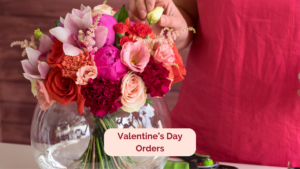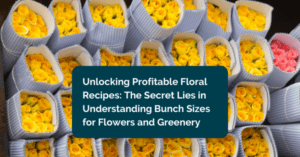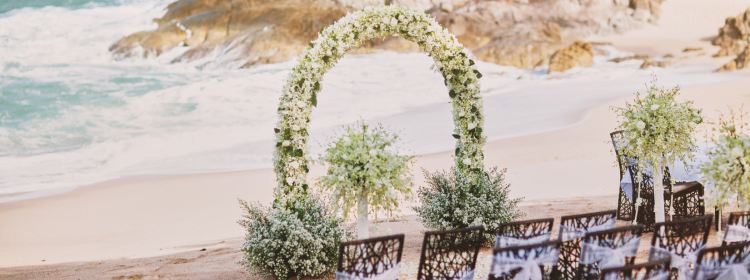
Right now, the floral industry is booming. The practice of creative innovation has completely revolutionized how people consider and adore flowers. There are now great career opportunities for those who are passionate about becoming a florist. Flowers are typically sold by professional florists in arrangements in different settings. These include grocery stores, dedicated shops, home based businesses and online platforms.
The primary focus of studio professionals is event floristry. These experts bring their extensive experience in weddings, corporate events, as well as in special occasions. This specialized knowledge guarantees sound design for the various event types. If you are wondering “how to be a florist” yourself? In this guide, you will understand tips on how to become a florist designer or an event florist.
Unleashing Your Creativity as a Floral Designer
If you are a creative soul looking for an expression outlet, then becoming a florist is a good profession to enter. Florists create elegant florals based on a client’s choice of design and color. The focus is solely on building beautiful flower compositions and has nothing to do with other décor elements. Event planners manage the schedules and get the florists’ to deliver the arrangements at the venues. Their artistry transforms individual blooms into cohesive designs that complement the event’s aesthetic.
Whether you are creating a new floral design business or hoping to boost your existing one, you have got to focus on floral design. People who are new to floral design invariably ask, “How to get into floral design.” The answer is straightforward! Learning how to acquire in-demand skills helps you master florist basics. The following fundamentals are enough to make you get noticed as a respected floral designer in the field.
Understanding the Flower Power Industry
Floristry refers to preparing, selling and trading of flowers. Floral designs are in high demand especially for weddings, corporate events, funerals and family gatherings. Important celebrations simply wouldn’t feel complete without beautiful flower arrangements.
On top of working in the flower business, business owners handle more administrative responsibilities too. Furthermore, they take care of accounting, marketing, inventory, customer relations, and strategic planning. Different skills are needed for these entrepreneurial tasks as opposed to arrangement creation.
What Makes an Event Florist Special?
If you wish to enter the profession of event florist, it is crucial to know what an event florist actually does. These specialized people create extravagant flower arrangements to mark various events and occasions. They make the ordinary into the extraordinary with their expertise in thriving floral designs.
The event florists’ relationship with the clients is, in some ways, even closer than that of a wedding florist; they learn about design preferences, aesthetic expectations, and decoration needs. They are really the artists that can turn a boring event into a great celebration or a memorable experience. To become a top event florist, you have to feature your own creativity to propagate your florals.
The Essential Role of Floral Designers
Floral designers use their exceptional flower arrangements to meet client needs. However, the profession is riddled with challenges, especially during peak periods such as a high volume of holidays. You have to be able to use your hands and, at the same time, be able to see with your eyes. The long work hours during busy seasons are a matter of work-life balance. People ask, “How to become a floral designer?” or “How do I become a floral designer?”. Here, it boils down to mastering a number of behind-the-scenes tasks.
Floral designers who have succeeded know how to maintain efficient workflow and ideal smooth event execution. Their core functions include:
- Being prepared to meet clients as required and understand what specific floral needs and expectations they have.
- Developing feasible successful plans that work on both floral and nonfloral event components.
- Planning meticulously behind the scenes to ensure flawless execution of floral designs.
- Collaborating effectively with venue coordinators and wedding planners to create cohesive designs.
Daily Life as a Florist: What to Expect?
In addition to creative design work, the florists do handle plenty of other things. Tasks involve watering plants, keeping them trimmed and in the best position for maximal uptake, delivering completed orders and clearing the workspace. The practical activities are supportive of the artistic aspects of the profession. For those curious about ‘how to be a florist,’ it is important to know about the responsibilities each day would entail.
- Creating creative flower arrangements for diverse events, including weddings, parties, and funerals.
- Processing flowers by trimming stems and removing thorns for a beautiful presentation.
- Using and maintaining specialized tools to ensure high-quality floral designs.
- Manage customer orders efficiently and ensure timely delivery.
- Handling event installations, including setup and teardown operations.
Your Journey to Becoming a Fabulous Florist
Plenty of florists keep regular hours but almost always work evenings and weekends. The pay for American florists typically ranges from $22,500 to $45,000 a year, but pay is still quite variable. Income potential is greatly affected by experience, service offerings, pricing strategies, and marketing effectiveness. Ambitious professionals usually make more than the rest of the people.
- Hands-on Experience: Working directly with flowers teaches the intricacies of floral design. To gain practical knowledge, consider associating with local flower shops by doing an internship.
- Home practice: Working at home on flower designs will enhance your skills and style.
- Classes, courses and workshops: This includes enrolling in classes that cover flowers design, courses and workshops to cover the technical skills and industry knowledge
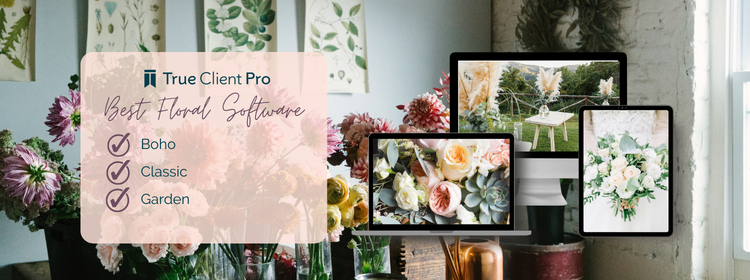
First Steps into the Floral World
An internship or entry level position allows you to introduce yourself with floristry. The practical experience answers questions such as “how to become a floral designer?” Specifically, holiday seasons require very intensive schedules due to the increased demand. There are particularly busy periods in their life such as Valentine’s Day, Mother’s Day and Christmas.
Most studio flower designers take the time to get to know clients’ specific visions and are able to give very intimate attention to clients’ needs. Since they’re on a smaller scale, they can focus highly on custom looks and even on very intricate details. The craftsmanship devoted to each arrangement reflects the desires of the client.
Due to lower overhead costs, these specialists have a greater degree of creative freedom. Without any limitations, studio florists experiment with fresh ideas and new designs. This can produce truly one-of-a-kind arrangements that are different from standard offerings.
Retail Florists vs. Event Florists: Choosing Your Path

A typical day at a retail florist is spent at a flower shop with regular hours. Daily customer orders and walk-in clients are served by them. On the other hand, event florists design floral arrangements for a big event like weddings, corporate functions and funerals. The timing of the event affects their schedules. For those asking how to become a flower arranger, it’s event floristry they should consider specializing in.
An event designer, on the other hand, orchestrates everything that is visually and experientially possible in an occasion. This comprehensive role encompasses selecting chairs, tables, linens, napkins, lighting, dance floors, and entertainment options. Event designers craft immersive experiences that engage all five senses. They consider not just visual elements but also the emotions, textures, sounds, scents, and flavors guests will encounter. This knowledge answers questions about “how to become a floral designer” more specifically.
Traditional Flower Shops: Reliability and Convenience
Flower shops offer accessible retail spaces where customers browse pre-made arrangements in person. Their storefront locations provide immediate visual inspiration for potential purchases. The ready availability of fresh flowers makes shops perfect for last-minute orders. Their inventory supports spontaneous purchases and quick-turnaround events effectively. Customers rely on this convenience when unexpected needs arise.
While offering diverse floral products, traditional shops may have limited customization capabilities. Studio florists focus on specialized events, while they have a standardized working approach. For retail orders, ten to twenty flower varieties are common and the designs remain beautiful but are also more streamlined. This way you easily fulfill some colour or flower request without spoiling the aesthetic.
Want to crush your first event as a florist?
Preparation for your very first event can be intimidating, but with some preparation, you’ll have a much higher chance of success. These are the things you can follow in practical experience to answer “how to become a florist designer”:
- Begin with a simple occasion such as a baby shower or a small get-together with the family.
- Start with easy but elegant designs such as centerpieces.
- You can ask for the client’s feedback and identify areas to improve and refine your approach.
Exploring Different Floristry Career Paths
You may become a florist, engaged in client management, logistics and marketing. If you are wondering “how do you become a floral designer” then think of designing beautiful arrangements. This path holds physical demands and seasonal factors which are difficult.
Sure, loving flowers is fun. But fortunately, loving flowers can become a living and thriving business, right? The real magic happens there. Designing floral arrangements for celebrity events or high-end weddings might seem like a dream, but it’s possible with the right approach. Designers interact closely with event planners, who coordinate time in a way that is much like digital orchestration. Therefore, this partnership helps clients stay on schedule, and designers focus on that aesthetic aspect.
The Physical and Emotional Side of Floristry
There are very different timelines for retail arrangements and wedding florals by design. Batches of flowers typically arrive with closed blooms that open over days. This slow unfurling forms a constantly changing display in the home. Combat stress through advanced planning and streamlined operations.
Wedding florals hit their peak of openness precisely on the big day. Florists plan the blooming process days in advance. Every bloom shows its most magnificent form during the celebration, creating picture-perfect moments. Floristry can sometimes be physically demanding and emotionally draining. Long hours may cause back pain, knee issues, and other health problems. Using ergonomic tools helps manage these physical challenges effectively. The emotional demands peak during busy seasons like wedding season.
Why Being an Event Florist Rocks?
Top floral designers don’t wait for big opportunities to land in their laps. They make connections and get involved in the industry in creative ways. A lot of high-end vendors don’t refer new designers, but they do need help with photo shoots and styled events. Each opportunity comes with an email or a social media reach out. You will be able to have important conversations with industry leaders by offering to assist them with creative projects. If you are choosing a floristry career, then you will be receiving amazing rewards, including:
- Creative Expression: Having a work schedule that is flexible but still has healthy boundaries.
- Client Value: Create unforgettable moments through your skill and expertise.
- Flexibility: Enjoy adaptable work schedules while maintaining healthy boundaries.
- Professional Growth: Build extensive networks through diverse client interactions.
Navigating Industry Challenges
Others specialize in weddings and make their talent a full time business. The fact that it’s still in demand means wedding florists will remain an attractive niche for the event design enthusiast. If you’re planning to start in a flower shop, you get hands-on experience which is invaluable. Begin with small arrangements that are designed for everyday customers before graduating to more extravagant wedding designs.
The basis for a career in luxury floral design begins with learning the basics in a shop environment. There are some challenges to the florist industry, especially regarding seasonality. This is when you can freelance or offer workshops to continue having a steady income during slower periods. Often, new florists make common mistakes such as:
- Underpricing their services and expertise.
- Being overcommitted to too many clients at the same time.
- Neglecting proper contracts and agreements.
- Estimating without including transportation and labor costs.
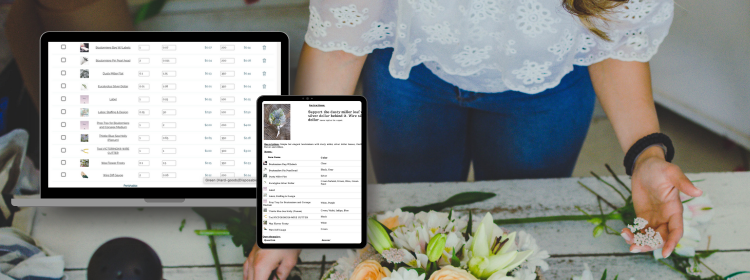
Making Bank as a Florist
In floristry, profitability is still the main consideration in financial terms. Set proper prices to ensure success and manage your optimum number of clients. Controlling costs while at the same time achieving the maximum possible revenue through efficient operations. Income of individuals varies from one place to another and also depends on experience. In 2021, actual florist pay in the U.S. averaged about $30,000 per year or $13 per hour.
Still, they can earn significantly more if they are involved in organizing high-end events in major markets. The salary range for florists in California is between $47,975 and $71,421 per year. Salary.com reports that, as of July 2023, the average floral designer in the U.S. makes $54,983 annually. Earnings grow with experience, reputation, and the ability to take on high-budget projects.
Essential Tools for Florist Success

Succeeding as a florist requires leveraging modern tools. Advanced software can streamline the processes including inventory management, client proposals, and event planning. Additional essential tools include floral coolers, specialized design equipment, and customer relationship management software.
Developing a signature floral design style takes years of practice. Many successful designers spend about five years refining their niche. The key indicator of the right path? An undeniable rush of excitement when creating. A strong vision and a deep connection to the work make all the difference. Big-budget weddings and celebrity events seek out-of-the-box vendors who push creative boundaries. Massive PR and marketing firms handle these events, and they look for designers who stand out. Those who bring fresh ideas and a bold perspective earn attention in elite circles.
Core Responsibilities of Successful Event Florists
Networking with the right people means stepping into the spaces where trends take shape. Working with established designers allows a fresh florist to gain experience while learning how the top names operate. It’s not just about arranging flowers, it’s about becoming part of the conversation in the wedding and event industry. Event florists manage numerous responsibilities, including:
- Converting leads into clients through effective sales techniques and tools.
- Developing both floral and non-floral event elements for seamless execution.
- Collaborating with clients and stakeholders to develop stunning designs.
Breaking Into the Blooming Business
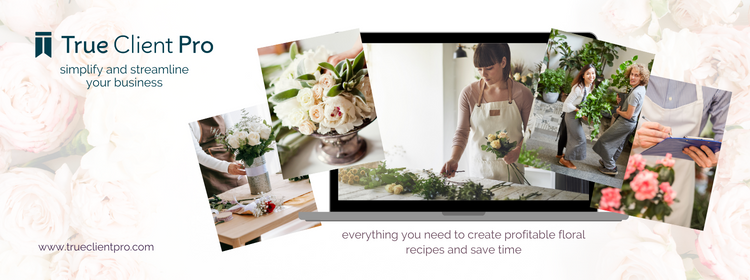
If you plan to enter the floral industry, you need to show your creativity and artistic talent. Learn from experts while developing your unique style rather than simply imitating others. Today many successful florists employ advanced business systems. A floral designer is not just a job, but a way to spread beauty across the world. Art is not easy to learn, but for those that have the passion they have no limits.
CRM tools enable organizations to keep a handle on the clients and their preferences. Furthermore, these systems also allow inventory tracking and the creation of floral recipes to cut down on time and errors. Refine core skills through appropriate courses and workshops. Credibility as a top floral designer is acquired through advanced training. Therefore, freelance projects, internships, or connections with professionals who are either experienced or highly knowledgeable will be sought for learning opportunities.
Top Tips for Success as an Event Florist
Creativity drives floral design. The best florists do not see flowers as just plants but as a medium for art. Top designers also set themselves apart from others with unique and meaningful arrangements.
To build a solid reputation in the floral industry, you have to use and plan strategically. Every aspect of floral design is highly detail-focused. Every petal matters. The ability to create balanced, visually stunning arrangements comes with practice and precision. Consider these essential tips:
- Develop a strong professional networking to support business growth opportunities.
- Work with wedding planners, photographers, and venue coordinators to design products that are unique.
- Focus on effective branding and marketing, including developing a strong online presence through SEO strategies.
Conclusion
The demand for flower designers and event florists is growing in 2025. This work is both creatively and professionally satisfying. The advent of modern tools also helps meet the client’s needs by delivering exceptional services that are unique in the competitive market.
Whether you dream of creating stunning wedding arrangements or running your own flower shop, the path to becoming a successful florist begins with passion and continues with dedicated skill development. The flower business combines creativity with practical business sense – a perfect match for those who love both beauty and entrepreneurship.

Remember that learning “how to become a wedding florist” takes time and practice. Each bouquet and arrangement improves your skills and builds your reputation. Through thriving floral designs and effective floral management, your blooming career will grow more beautiful with each passing season.


